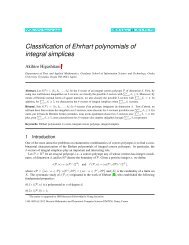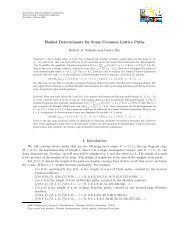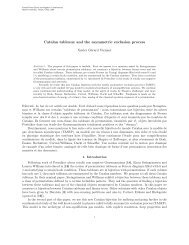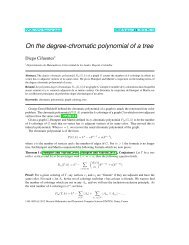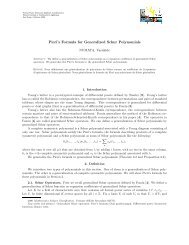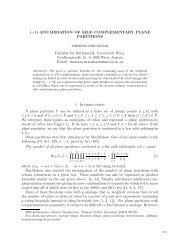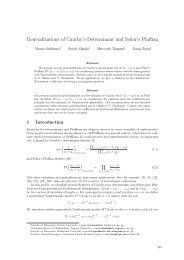Polynomial functions on Young diagrams arising from bipartite graphs
Polynomial functions on Young diagrams arising from bipartite graphs
Polynomial functions on Young diagrams arising from bipartite graphs
Create successful ePaper yourself
Turn your PDF publications into a flip-book with our unique Google optimized e-Paper software.
262 Maciej Dołęga and Piotr Śniady<br />
3 Differential calculus of <str<strong>on</strong>g>functi<strong>on</strong>s</str<strong>on</strong>g> <strong>on</strong> <strong>Young</strong> <strong>diagrams</strong><br />
3.1 C<strong>on</strong>tent-derivatives<br />
Let F be a functi<strong>on</strong> <strong>on</strong> the set of generalized <strong>Young</strong> <strong>diagrams</strong> and let λ be a generalized <strong>Young</strong> diagram.<br />
We ask how quickly the value of F (λ) would change if we change the shape of λ by adding infinitesimal<br />
boxes with c<strong>on</strong>tent equal to z. In order to answer this informally formulated questi<strong>on</strong> we define a<br />
derivative of F with respect to c<strong>on</strong>tent z; this definiti<strong>on</strong> is inspired by the Gâteaux derivative. We say that<br />
∂ Cz F (λ) = f(z)<br />
if f : R → R is a c<strong>on</strong>tinuous functi<strong>on</strong> such that for any ɛ > 0 and C > 0 there exists δ > 0 such that for<br />
any generalized <strong>Young</strong> <strong>diagrams</strong> ω 1 , ω 2 supported <strong>on</strong> [−C, C] such that ‖ω − ω i ‖ L 1 < δ for i ∈ {1, 2}<br />
∣ F (ω 1) − F (ω 2 ) − 1 ∫<br />
f(z) ( ω 1 (z) − ω 2 (z) ) dz<br />
2<br />
∣ ≤ ɛ ‖ω 1 − ω 2 ‖ L 1. (2)<br />
R<br />
The strange c<strong>on</strong>stant 1 2<br />
in the above definiti<strong>on</strong> appears because of the fact that we are working with a<br />
Russian c<strong>on</strong>venti<strong>on</strong> which rescales the length and the height of the <strong>Young</strong> diagram by a factor √ 2, hence<br />
Area(λ) = 1 ∫<br />
( )<br />
ω(z) − |z| dz.<br />
2<br />
R<br />
It can be shown using similar methods as in the case of a standard Gâteaux derivative that a c<strong>on</strong>tentderivative<br />
has the following properties:<br />
(A) If the derivative ∂ Cz F (λ) exists, then it is unique.<br />
(B) The Leibniz rule holds, i.e. if F 1 , F 2 are sufficiently smooth <str<strong>on</strong>g>functi<strong>on</strong>s</str<strong>on</strong>g> then<br />
∂ Cz F 1 F 2 = (∂ Cz F 1 ) F 2 + F 1 ∂ Cz F 2 .<br />
(C) For any integer k ≥ 2<br />
∂ Cz S k = (k − 1)z k−2 .<br />
The next propositi<strong>on</strong> shows important properties of derivati<strong>on</strong> of a polynomial functi<strong>on</strong> <strong>on</strong> Y.<br />
Propositi<strong>on</strong> 3.1 Let F be a polynomial functi<strong>on</strong> <strong>on</strong> Y.<br />
• For any <strong>Young</strong> diagram λ the functi<strong>on</strong> R ∋ z ↦→ ∂ Cz F (λ) is a polynomial.<br />
• For any z 0 ∈ R the functi<strong>on</strong> Y ∋ λ ↦→ ∂ Cz0 F (λ) is a polynomial functi<strong>on</strong> <strong>on</strong> Y.<br />
• For any integer k ≥ 0 the functi<strong>on</strong> Y ∋ λ ↦→ [z k ]∂ Cz F (λ) is a polynomial functi<strong>on</strong> <strong>on</strong> Y.<br />
Proof: By linearity it is enough to prove it for F = ∏ 1≤i≤n S k i<br />
. Then, thanks to the properties (B) and<br />
(C), we have that<br />
∂ Cz F =<br />
∑ ∏<br />
S kj (k i − 1)z ki−2 ,<br />
1≤i≤n<br />
1≤j≤n<br />
j≠i




